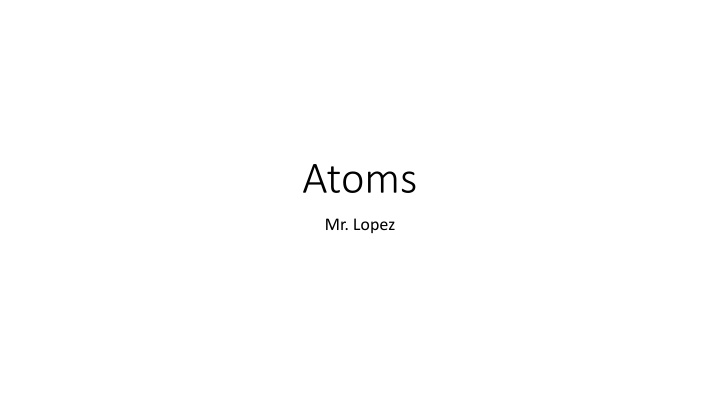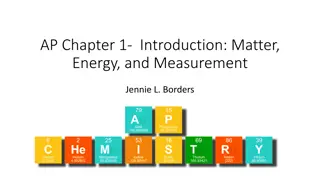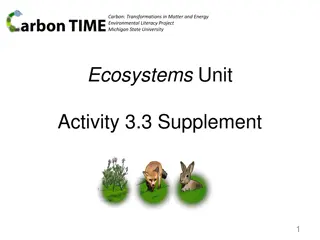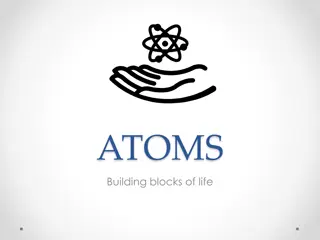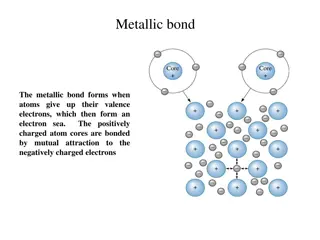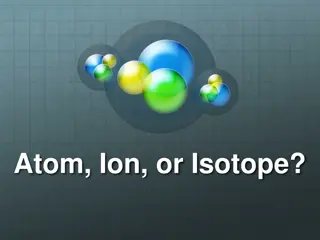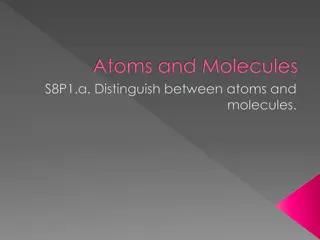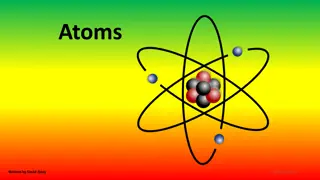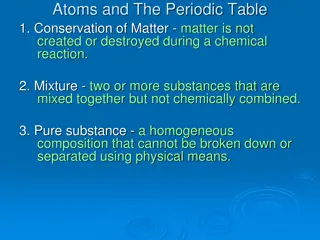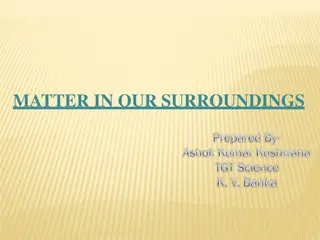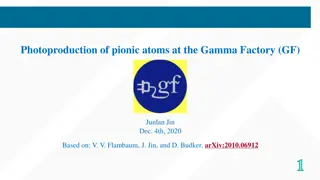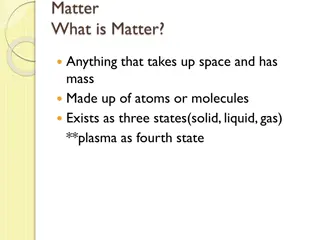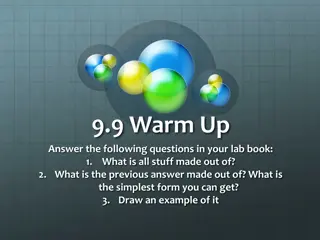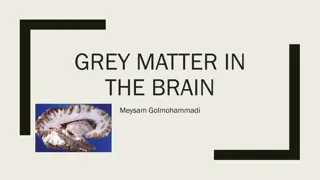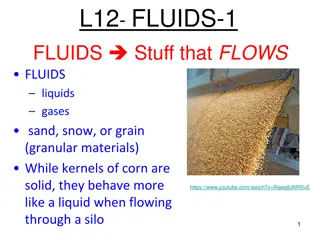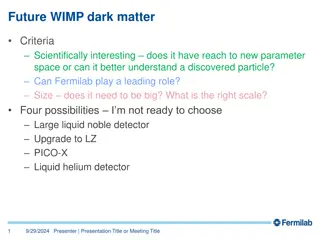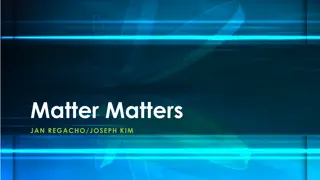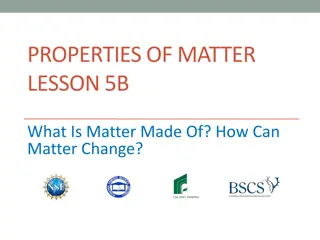Scientific Exploration of Atoms and Matter
Delve into the scientific theory of atoms, the building blocks of matter. Learn about their structure, charges, and significance in understanding the elements that form compounds. Explore key concepts such as sub-atomic particles, electron clouds, and nucleus composition. Assess your knowledge with questions related to atomic properties and interactions with other elements. Engage with images depicting atom models and historical discoveries by prominent scientists like J.J. Thomson. Understand the fundamental role atoms play in shaping the world around us.
Download Presentation

Please find below an Image/Link to download the presentation.
The content on the website is provided AS IS for your information and personal use only. It may not be sold, licensed, or shared on other websites without obtaining consent from the author.If you encounter any issues during the download, it is possible that the publisher has removed the file from their server.
You are allowed to download the files provided on this website for personal or commercial use, subject to the condition that they are used lawfully. All files are the property of their respective owners.
The content on the website is provided AS IS for your information and personal use only. It may not be sold, licensed, or shared on other websites without obtaining consent from the author.
E N D
Presentation Transcript
Atoms Mr. Lopez
Benchmark SC.8.P.8.7 SC.8.P.8.7 Explore the scientific theory of atoms (also known as atomic theory) by recognizing that atoms are the smallest unit of an element and are composed of sub-atomic particles (electrons surrounding a nucleus containing protons and neutrons)
Atoms Structure and charges SC.8.P.8.7 How they relate to matter Charges location Scientific contribution
Assessment Question A British scientist named J. J. Thomson discovered the electron in 1897. He suggested that the atom looked like the model below. A. Both models contain a nucleus and an electron cloud. B. Both models include negative charge and positive charge. C. Both models show positive charge spread through an area of the atom. D. Both models show most of the mass of the atom at the center.
1. Assessment Question Atoms are a basic building block of certain types of matter. Atoms make up the elements that combine to form compounds to make up much of what we use every day. Which of these substances is NOT made out of atoms? A. oxygen B. protons C. trees D. carbon dioxide
2. Assessment Question What is the smallest particle of an element that has all the chemical properties of the element? A. an atom B. a molecule C. an electron D. the nucleus
3. Assessment Question Which of these particles is thesmallest? A. an atom B. a nucleus C. a proton D. an electron
4. Assessment Question Which particle s mass is similar to the mass of a proton? A. an atom B. a nucleus C. a neutron D. an electron
5. Assessment Question The element phosphorus reacts with oxygen to produce a bright flame. Which is the smallest particle that will also react with oxygen to produce a bright flame? A. a phosphorus atom B. a phosphorus molecule C. an electron in a phosphorus atom D. the nucleus of a phosphorus atom
6. Assessment Question Consider a wooden chair and a balloon. What do these two objects always have in common? A. Both are made of atoms. B. Both have the same mass number. C. Both are made of the same kind of atom. D. Both are made of the same number of atoms.
7. Assessment Question A row of 100 million atoms of a single type would be only about 1 centimeter (cm) long. What occupies most of this space? A. water B. nuclei C. electrons D. empty space
8. Assessment Question Which group lists the parts of an atom from the most massive to the least massive? A. proton, nucleus, electron B. nucleus, electron, proton C. electron, nucleus, proton D. nucleus, proton, electron
9. Assessment question Angelo drinks a large glass of water every morning when he wakes up. Which statement best describes the chemical makeup of the water Angelo drinks? A. electrons. B. C. chemical bonds. D. It is made up of protons and neutrons arranged in a repeating pattern. It is made up of a single atom composed of protons, neutrons, and It is made up of an electron cloud surrounding a dense nucleus. It is made up of many molecules containing atoms joined together by
10. Assessment Question Which of these statements describes a fact about an atom s nucleus? A. It is negatively charged. B. It is smaller than an electron. C. It is the same size in all atoms. D. It is made of neutrons and protons.
11. Assessment Question Which of these statements describes a fact about an electron cloud? A. It is the most massive part of an atom. B. It is made up of electrons and neutrons. C. It is where an atom s electrons are found. D. It is located in the center of an atom s nucleus.
12 Assessment Question Explain how an atom is related to an element.
13. Assessment Question Write two or three sentences about how our understanding of atoms today is both similar and differentfrom Thomson s model.
14. Assessment Question Marcus wants to use two objects to compare the sizes of a proton and an electron. If he uses a basketball for a proton, which object would best represent an electron? A. a pea B. a bowling ball C. a beach ball D. a soccer ball
Mike is drawing a model of an atom. He will draw the electron cloud first, and then he will draw the nucleus. Where will he draw the nucleus of the atom? A. on the outer edge of the electron cloud B. among the electrons in the electron cloud C. between the center of the atom and the electron cloud D. in the center of the atom, surrounded by the electron cloud
15. Assessment Question The element lithium (Li) has an atomic mass of 3 and a mass number of 7. Explain how you know that the diagram above represents a lithium atom.
16. Assessment Question Elements and compounds are both made up of atoms. Explain how an atom is related to an element. How do the properties of an atom compare to the properties of the related element?
17. Assessment Question The element lithium (Li) has an atomic number of 3. Identify what each label stands for in the atom model. Explain how you know that the diagram above represents a lithium atom.
18. Assessment How does the atomic theory relate to your life? Describe the particles that make up an atom.
Atomic Mass, Number SC.8.P.8.7 Identify an element by atomic number Calculate atomic mass Calculate atomic number Identify number of valence electrons Identify number of valence electrons Identify the number of P, N, E in an element to determine if it an isotope
Benchmark SC.912.P.8.4 SC.912.P.8.4: Explore the scientific theory of atoms (also known as atomic theory) by describing the structure of atoms in terms of protons, neutrons, and electrons and differentiate amongst these particles in terms of mass, electrical charges and locations within the atom.
Atomic number/Isotope/Atomic mass C= 0 copying notes /2 with only your table H=ask 3 before me A= concept map with details M=none P= Looks like students copying down the concept map, looking for text evidence and details S= Check for success and ticket if you can make the time as a group.
Comparing Particles Masses text evidence 279-280 The mass protons and neutrons are about equal. Electrons are much smaller about 1,840 electrons equals 1 proton or neutron. Protons and neutrons make up almost all the mass of an atom. Atoms are measured by atomic mass units called (amu).
Atomic number p.279 The number of protons in the nucleus of an element tells us what type of element it is. The definition of an element is based on it s atomic number. For example oxygen has 8 protons in the nucleus so the atomic number is 8.
Isotopes p. 280 Atoms with the same number of protons and different number of neutrons are called isotopes. The mass number would be the total of protons and neutrons in an atom. If the number of neutrons changes oxygen will become an isotope. For example oxygen is naturally 16 for atomic mass (8p + 8n = 16). But if you add another neutron it will change to Oxygen-17. Calculate mass number by adding number of protons and number of neutrons.
Explain why all three oxygens react the same chemically? P.280 The reason the isotopes react the same is because the number of electrons stay the same which gives it the chemical reactivity. The only thing different in an isotope is the number of neutrons change.
280 Math Tool Box Copy Chart Atom 8e- 8e- 8e- Isotope Oxygen-16 Oxygen-17 Oxygen-18 Protons 8 8 8 Neutrons 9 10 8
280 Math Tool Box Copy Chart Element Mass number P+ n e- Fluorine 10 9 19 9 Argon 40 22 18 18 Calcium 41 20 20 21
1. Assessment 1. Assessment Each element is made up of different atoms. The table below compares two elements. What do the elements in the table have in common? A. Atoms in each element have 10 nuclei. B. Atoms in each element have 10 protons. C. Atoms in each element have 10 neutrons. D. Atoms in each element have 10 electrons. Element 1 Element 2 Atomic number 10 9 Mass number 20 19
2. Assessment An atom s mass number is 210 and its atomic number is 85. How many neutrons does the atom have? A. 85 B. 125 C. 210 D. 295
3. Assessment Questions Shona knows that two atoms have the same number of protons. What else can she assume about the two atoms? A. They have the same mass number. B. They have the same electric charge. C. They have the same number of neutrons. D. They have the same chemical properties.
4. Assessment Question An atom of vanadium (V) has 23 protons and 28 neutrons. How many electrons does a neutrally charged atom of vanadium have? A. 5 B. 23 C. D. 51 28
5. Assessment Question An atom of lead has the atomic number 82 and a mass number of 207. How many neutrons does this atom of lead have? A. 82 B. 125 C. D. 289 207
6. Assessment Question What is the mass number of an atom that has 4 protons, 4 electrons, and 5 neutrons? A. 4 B. 5 C. D. 13 9
7. Assessment Question Any atom that has 13 protons is an aluminum atom. Which statement best describes what would happen if a proton were added to an aluminum atom? A. The atom would lose electrons. B. The atom would have a negative charge. C. The atom would no longer be aluminum. D. The atom would have a smaller atomic number.
8. Assessment Question The chart below shows the atomic numbers and mass numbers for two elements. Element 2 has a greater atomic number and mass number than element 1. Element 1 Element 2 Atomic number 26 31 Mass number 56 70 How many more neutrons does element 2 have than element 1? A. 5 B. 9 C. 14 D. 39
9. Assessment Question An atom of the element gallium (Ga) has 31 protons and 39 neutrons. What is the atomic number of gallium? A. 8 B. 31 C. D. 70 39
10. Assessment Question Why is the mass of an atom s electrons not included in the atom s mass number? A. The electrons move so fast that their mass cannot be measure B. The electrons negative charge cancels out their masses. C. The electrons mass is represented in the atomic number. D. The electrons are much less massive than the rest of the atom.
